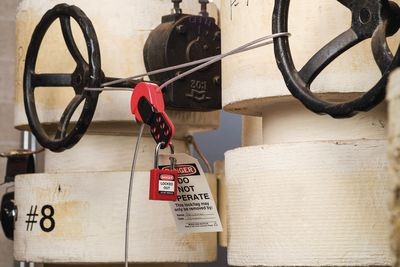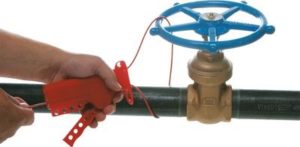Lockout Tagout (LOTO) Systems
In almost every company, regular maintenance, inspections or cleaning of machines and equipment are necessary. Lockout tagout systems (also known as LOTO) protect your employees during these activities and prevent accidental activation of the power source. In the SETON online shop, you can buy a variety of products for maintenance protection, e.g.:
- Interlocks for electrical systems
- Cable and valve interlocks
- Various lockout locks and locking brackets
- Maintenance tags and lockout labels
- Lockout stations and accessories
Lockout tagout is required in many industries and is recognized worldwide as best security practice. It is an effective and planned safety measure for locking and marking mechanical and electrical hazards such as valves, ball valves, circuit breakers and fuses.
What is Lockout Tagout?
Lockout tagout or also LOTO means maintenance security and has its origin in the USA. Here, the OSHA (Occupational Safety & Health Administration) has developed a system to reliably protect employees during maintenance or cleaning work from serious accidents, e.g. electric shocks. The use of LOTO systems has proven itself in many areas and has become a globally recognized safety concept.

More security through LOTO
Lockout tagout stands for locking and marking. These devices are attached directly to energy sources and ensure operational safety. They keep the energy supply of systems and machines separate during maintenance work and ensure a safe and reliable shutdown. Accidental reconnection is prevented.
Imagine you are repairing a machine. The emergency stop switch is unlocked and not marked. An employee switches on the machine as usual and starts working. Or someone opens an unsecured valve and you are exposed to toxic or hot gases. Such terrible accidents at work can be easily prevented by using LOTO systems.
Reasons for lockout tagout systems
- To prevent personal injury and damage to property during maintenance, servicing, and cleaning work
- Higher productivity through trouble-free production processes
- Minimization of unplanned machine downtimes
- Better planning and cost reduction
- Legal certainty
- Protection against manipulation and theft
Legal regulations on lockout tagout
What are the legal regulations on the subject of “lockout tagout”? In Germany, there is currently no legal requirement demanding the introduction of specific lockout tagout systems. However, this safety concept is ideal for implementing the maintenance assurance and accident prevention required by our laws.
The German Ordinance on Industrial Safety and Health (BetrSichV) defines these requirements in the “Minimum requirements for the use of work equipment by employees at work”. Appendix 1 describes how command devices must be provided and arranged or can be secured. Appendix 2 of the “Minimum safety and health requirements for the use of work equipment by workers at work” stipulates that modification, repair and maintenance work may only be carried out when the work equipment is at a standstill. During such work, moving parts must be secured against being switched on and against unintentional movement.
DIN EN “Electrical equipment of machines (Part 1)” section 5.3 requires that the main switch must be lockable in the OFF position (e.g. by installing padlocks).
The accident prevention regulation DGUV regulation 3 (BGV A3) describes under § 6 how work must be carried out on active parts. An important point is mentioned here in paragraph 2, among others. There it says: “Before starting work on active parts of electrical systems and equipment, the voltage-free state must be established and ensured for the duration of the work”. This also applies to unprotected adjacent parts or active parts that are in the vicinity (§ 7).
Basic steps to implement a lockout tagout system
- Inventory – identify energy sources (risk assessment) and define them in a list. Define processes and responsibilities
- Identify and clearly label energy control points (e.g. switches, fuses, valves) (e.g. with valve marks)
- Purchase suitable lockout tagout locking system
- Train employees
Who may use the systems?
The disconnection and connection of machines and systems and the necessary repair or maintenance work may only be carried out by persons who have the appropriate training, qualifications, specialist knowledge and experience (e.g. machine operators, electricians). In addition, a permit from the company must be available.
Ordering the right LOTO system
Every working environment has different requirements. In advance, it must be considered where on the respective machine the energy source must be switched off and locked. Is it the main switch, the fuse or maybe a valve?
Cable and valve interlocks
 Cable interlocks and valve interlocks are used to reliably interlock mechanical hazard sources such as valves, ball valves or gas and air lines. They hold levers and Co. securely in a certain position. These lockout tagout locking systems are usually made of very stable materials such as steel or impact-resistant plastic. All devices have the possibility to be locked in combination with a security lock
Cable interlocks and valve interlocks are used to reliably interlock mechanical hazard sources such as valves, ball valves or gas and air lines. They hold levers and Co. securely in a certain position. These lockout tagout locking systems are usually made of very stable materials such as steel or impact-resistant plastic. All devices have the possibility to be locked in combination with a security lock
Interlocks for electrical hazards
The interlocks for electrical hazards are mounted directly on the respective power sources such as circuit breakers, buttons, and electrical plug connections. These LOTO products reliably protect against accidental switch-on and unauthorized access. They are easy to install without additional tools and are made of durable and non-conductive materials such as nylon or polyester. All products can be additionally locked with a lock.


Locking brackets
Locking brackets allow a machine to be locked by several employees at the same time (group locking). It usually consists of an overlapping safety hook and several holes in the body of the shackle. The respective locks can be fitted here. Locking brackets provide an even higher level of security. The safety hook (shackle) can only be opened and removed after all responsible employees have removed their locks. They are available in solid steel or lightweight nylon.
Locking brackets
Locking brackets allow a machine to be locked by several employees at the same time (group locking). It usually consists of an overlapping safety hook and several holes in the body of the shackle. The respective locks can be fitted here. Locking brackets provide an even higher level of security. The safety hook (shackle) can only be opened and removed after all responsible employees have removed their locks. They are available in solid steel or lightweight nylon.


Maintenance tags and lockout labels
Maintenance tags are used to keep employees away from the machine or system during repair work. They usually contain warning symbols, important notes, and space for your own text. They are attached directly to the interlock or in the immediate vicinity.
Lockout locks and lockout boxes
LOTO locks include security locks, insulated locks, aluminum, or brass locks. They are particularly tamper-proof and are used as an additional security measure to lock the lockout locks. They are available in different colors, materials, and locks. Lockout boxes or group lockout boxes serve as a collection point for e.g. group locks

